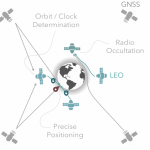The GNSS world has gotten pretty complicated.
European nations and industry often comment enviously on the U.S. advantage of having a single political entity in charge of its GNSS program. They contrast the sole “ownership” of the Global Positioning System with Galileo’s dependence on consensus among the 25 member nations of the European Union and the 17 national space agencies represented in the European Space Agency.
But the closer one gets to the “unitary” American polity and GPS policy and management, the more fragmented it appears.
The GNSS world has gotten pretty complicated.
European nations and industry often comment enviously on the U.S. advantage of having a single political entity in charge of its GNSS program. They contrast the sole “ownership” of the Global Positioning System with Galileo’s dependence on consensus among the 25 member nations of the European Union and the 17 national space agencies represented in the European Space Agency.
But the closer one gets to the “unitary” American polity and GPS policy and management, the more fragmented it appears.
Competition for budget within DoD programming. Different perspectives among war-fighting commanders, system operators, DoD’s engineering and acquisition arm in the GPS Wing, and policy makers in the Pentagon.
Tension between civil and military requirements and equities. A welter of GPS-related activities within the civil agencies, both as service providers and users of GPS.
If anyone can sort this out and has the mandate to do so, that would be the National Space-Based Positioning, Navigation, and Timing (PNT) Executive Committee (ExCom), along with its secretariat and support staff in the National Coordination Office (NCO).
Established by President Bush’s December 2004 National Security Presidential Directive on space-based PNT, ExCom is co-chaired by the deputy secretaries of defense and transportation or their designated representatives.
The remaining committee members were representatives at the equivalent level from the departments of state, commerce, and homeland security, the Joint Chiefs of Staff, and the National Aeronautics and Space Administration. Other departments and agencies could join “as required.”
With the PNT ExCom’s membership of deputy secretaries, the number-two officials in the federal departments, no issues fall outside the scope of their duties. This makes it easier to implement agreements reached at the ExCom meetings.
In the short run, the 2004 presidential directive made things even tougher. Its requirement for DoT to fund any further improvement of civil GPS capabilities beyond L2C and L5 underlined the already fragmented relationships among civil agencies on GPS matters.
The ExCom almost immediately fell behind the White House schedule for such things as drafting a five-year PNT strategic plan and establishing a PNT interference detection and mitigation (IDM) plan.
During 2005, not a lot of visible progress occurred. Towards the end of that year, Robert England, DoD deputy secretary, and Deputy Secretary of Transportation Maria Cino, took on the responsibilities of ExCom co-chairs.
The Department of Commerce agreed to house the NCO offices and a variety of department staff detailed to the office began to trickle in. With his arrival as DoD’s representative, England in particular invested considerable attention and energy into the ExCom.
Picking Up the Pace
By the end of 2005, the committee had selected Mike Shaw to serve as director. A career navigator in the U.S. Air Force, Shaw had filled a number of GPS-related policy and planning positions at both civil and military agencies over the years.
The NCO’s terms of reference were signed by the ExCom co-chairs in January 2006 and the pace began to pick up. The committee held four meetings that year, setting in motion work on the five-year strategic plan, the IDM plan, and creation of a high-level advisory committee.
These efforts came to fruition in 2007. In March, a 24-member board of independent experts, including international members, was convened with formal status under the Federal Advisory Committee Act (FACA).
Chaired by former defense and energy secretary James Schlesinger, the group has held three meetings since its founding, most recently March 27–28 of this year.
In August 2007, the president approved DHS’s IDM plan, which provides the framework for “organizing and managing cross-governmental activities to prevent, detect, report and mitigate sources of interference to GPS and its augmentations.”
DHS signed an implementation strategy for the plan into force in January of this year, and a publicly releasable fact sheet and summary of IDM Plan is expected soon.
Also last August, the ExCom published its National Five-Year Space-Based PNT Plan, which provides the committee with agency budgets enabling a comprehensive view of planned departmental funding for national space-based PNT systems and services.
Meanwhile, a major effort that began in 2006 is now approaching a crucial milestone. In January of that year, the ExCom tasked the NCO and DoD’s National Security Space Office (NSSO) to develop an overall portrait of the U.S. PNT architecture and a 20-year strategic outlook to guide near and mid-term decisions on PNT capabilities. The project was carried out by NSSO and the DoT’s Volpe Center.
Now, an “Architecture Guidance Memorandum” has been signed by John Grimes, assistant secretary of defense for networks and information integration/DoD CIO, and is awaiting approval by Tyler Duvall, assistant secretary for transportation policy.
That will allow public feedback on recommendations before the agencies move on to developing a detailed PNT transition and implementation plan.
An up-to-date and easy to navigate website <pnt.gov> provides a wealth of material on GPS, the ExCom, and NCO activities.
Where Power Resides
The 2004 policy directed the ExCom to “coordinate individual Departments’ and Agencies’ positioning, navigation, and timing program plans, requirements, budgets, and policies, and assess the adequacy of funding and schedules to meet validated requirements in a timely manner.”
Neither the PNT ExCom nor the NCO, however, has the power to enforce decisions at the departmental level. But the agencies’ representatives on the executive committee usually can.
Moreover, an ExCom work plan with 50-plus items agreed to by the departmental representatives last August comes with decision dates and the designation of responsible agency and agency personnel for each item on the list.
The civil contribution to financing GPS modernization is a good example. Recent action to sustain operations of the Nationwide Differential Global Positioning System (NDGPS) is another.
Both decisions were discussed at the recent ExCom meeting. But that merely was confirming agreements worked out off-stage by players in the various civil agencies affected by the program.
Now, having finally gotten itself up and running, scratching off items on its to-do list, the ExCom is looking ahead to the aftermath of this year’s elections. NCO staff are working on a comprehensive transition plan to transfer ExCom activities “smoothly and transparently” to a new administration in 2009.






